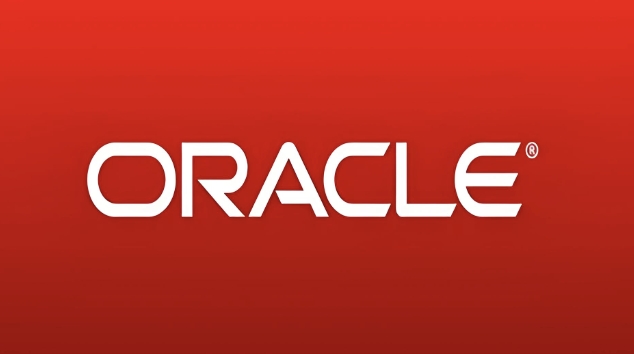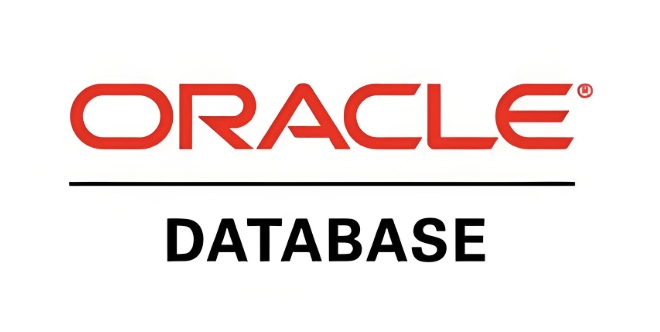Oracle Apex的初学者教程
Oracle APEX是基于Oracle数据库的低代码开发平台,可快速构建安全的企业级Web应用;2. 初学者推荐使用apex.oracle.com免费试用,无需安装,注册后创建工作区即可登录;3. 创建首个应用时,通过拖拽界面创建表(如EMPLOYEES)、自动生成表单和交互式报表;4. 在APEX Builder中熟悉导航器、页面设计器、属性面板等核心界面;5. 掌握工作区、应用、页面、区域、项、处理和验证等基本概念;6. 提升技能需学习SQL/PLSQL、动态动作、共享组件及图表仪表盘;7. 建议从简单的待办事项或联系人管理器开始,逐步添加认证、报表等功能,通过持续实践掌握开发。最终答案是:初学者应从免费工作区入手,利用内置模板快速构建应用,并通过实际项目逐步掌握核心功能与高级特性,最终实现企业级应用开发能力。

If you're just getting started with Oracle APEX (Application Express), you're in the right place. Oracle APEX is a low-code development platform that lets you build scalable, secure enterprise apps quickly, using only a web browser and SQL/PLSQL knowledge. It’s free with Oracle Database, making it a powerful tool for beginners and professionals alike.

Here’s a beginner-friendly guide to help you get up and running with Oracle APEX.
1. What is Oracle APEX?
Oracle APEX is a web-based software development environment built on top of Oracle Database. You can create interactive web applications — from simple data entry forms to complex reporting dashboards — without needing deep front-end or back-end coding skills.

Key features:
- Drag-and-drop interface builder
- Built-in security and scalability
- Responsive design (mobile-friendly apps)
- Integrated with Oracle Database
- Free to use with Oracle Database
APEX is ideal if you:

- Know basic SQL
- Want to build apps fast
- Don’t want to deal with complex web frameworks
2. How to Set Up Oracle APEX
Before you start building, you need access to an APEX environment. Here are your options:
Option 1: Use Oracle APEX on apex.oracle.com (Recommended for Beginners)
This is the easiest way to get started — no installation needed.
Steps:
- Go to //m.sbmmt.com/link/f925407353b2aaefee1a0c3b31be5fc1
- Click Try It Free or Sign Up
- Create a workspace (you’ll get a URL like
https://yourname-apex.apex.oracle.com) - Log in to your workspace
✅ Pros: Free, no setup, instant access
❌ Cons: Limited resources, not for production
Option 2: Install APEX in Your Own Oracle Database
For more control (e.g., local development or enterprise use).
Steps:
- Install Oracle Database (Express Edition is free)
- Install and configure APEX
- Set up Oracle REST Data Services (ORDS)
- Access APEX via
http://localhost:8080/ords
? This route is more complex and better suited once you’re past the beginner stage.
3. Your First APEX App: Step-by-Step
Let’s create a simple employee tracker app.
Step 1: Create a New Application
- Log in to your APEX workspace
- Click Create App
- Choose New Application
Step 2: Add a Page
- Click Create Page
- Select Interactive Grid from Table or View
- Choose Create Table (we’ll make one)
Step 3: Create a Table
APEX can generate a table for you.
Example table: EMPLOYEES
- Columns:
ID(Number, Primary Key),NAME(Varchar2),EMAIL,DEPARTMENT,SALARY - Let APEX generate forms and constraints
Click Create Table and Data Load.
Step 4: Build a Form and Report
- APEX automatically creates:
- A form to add/edit employees
- An interactive grid (report) to view all employees
- These are added as pages in your app
Step 5: Run Your App
- Click Run Application
- Test adding a few employees
- Play with the report (sorting, filtering, etc.)
You now have a working app — in under 10 minutes!
4. Understanding the APEX Interface
When building apps, you’ll work in the APEX Builder. Key areas:
- Navigator – Shows pages, regions, processes
- Page Designer – Visual layout tool (drag-and-drop)
- Properties Panel – Configure components (buttons, items, validations)
- Preview – See how the page looks
Spend time exploring:
- Adding buttons
- Creating validations (e.g., “Salary must be > 0”)
- Changing themes and templates
5. Key Concepts for Beginners
Here are a few terms you’ll see often:
- Workspace: Your private area in APEX (like a project folder)
- Application: A collection of pages (your app)
- Page: A single screen (e.g., login, report, form)
- Region: A section on a page (e.g., a chart, form, or grid)
- Item: Input fields (text box, date picker, etc.)
- Process: Logic that runs (e.g., saving data)
- Validation: Rules to check user input
Tip: Start with pre-built templates — they save time and teach you best practices.
6. Tips to Level Up
Once you’re comfortable:
- Learn SQL and PL/SQL — they’re essential for logic and data handling
- Explore dynamic actions — make pages respond to user input
- Use shared components — for navigation, security, and lists
- Try charts and dashboards — turn data into visuals
- Publish your app to a custom URL (if self-hosted)
Final Thoughts
Oracle APEX is beginner-friendly because it removes the complexity of full-stack development. You focus on data and user needs, not infrastructure.
Start small: build a to-do list, contact manager, or inventory tracker. Then gradually add features like authentication, reports, and emails.
The best way to learn? Just build.
基本上就这些 — no magic, just consistent practice.
以上是Oracle Apex的初学者教程的详细内容。更多信息请关注PHP中文网其他相关文章!

热AI工具

Undress AI Tool
免费脱衣服图片

Undresser.AI Undress
人工智能驱动的应用程序,用于创建逼真的裸体照片

AI Clothes Remover
用于从照片中去除衣服的在线人工智能工具。

Clothoff.io
AI脱衣机

Video Face Swap
使用我们完全免费的人工智能换脸工具轻松在任何视频中换脸!

热门文章

热工具

记事本++7.3.1
好用且免费的代码编辑器

SublimeText3汉化版
中文版,非常好用

禅工作室 13.0.1
功能强大的PHP集成开发环境

Dreamweaver CS6
视觉化网页开发工具

SublimeText3 Mac版
神级代码编辑软件(SublimeText3)
 使用Oracle Data Pump(ExpDP/IMPDP)比传统的出口/进口公用事业的优点是什么?
Jul 02, 2025 am 12:35 AM
使用Oracle Data Pump(ExpDP/IMPDP)比传统的出口/进口公用事业的优点是什么?
Jul 02, 2025 am 12:35 AM
OracleDataPump(expdp/impdp)相比传统export/import工具有明显优势,尤其适合大型数据库环境。 1.性能更强:基于服务器端处理,避免客户端中转瓶颈,支持并行操作,显着提升导出导入速度;2.控制更细粒度:提供INCLUDE、EXCLUDE和QUERY等参数,实现对象类型、表名、数据行等多维度过滤;3.可恢复性更高:支持作业暂停、重启和附加,便于长时间任务管理与故障恢复;4.元数据处理更完整:自动记录并重建索引、约束、权限等结构,支持导入时对象转换,确保目标库一致性。
 如何使用RMAN或其他方法克隆Oracle数据库?
Jul 04, 2025 am 12:02 AM
如何使用RMAN或其他方法克隆Oracle数据库?
Jul 04, 2025 am 12:02 AM
克隆Oracle数据库的方法包括使用RMANDuplicate、冷备份手动恢复、文件系统快照或存储级复制以及DataPump逻辑克隆。1.RMANDuplicate支持从活动数据库或备份中复制,需配置辅助实例并执行DUPLICATE命令;2.冷备份方法需关闭源库并复制文件,适合可控环境但需要停机时间;3.存储快照适用于企业级存储系统,速度快但依赖基础设施;4.DataPump用于逻辑层级复制,适合迁移特定模式或表。每种方法均有其适用场景和限制。
 Oracle如何使用重做和撤消机制来管理交易和回滚?
Jul 08, 2025 am 12:16 AM
Oracle如何使用重做和撤消机制来管理交易和回滚?
Jul 08, 2025 am 12:16 AM
OracleSurestransActionDurability andConsistencySandOforCommitsandUndoforroLlbacks.duringAcommit,OracleGeneratesAcommitRecorDintherEdologbuffer,MarkssaSpermanentInRogs,andupdateTeStestestestestestestestestestestestestestestestestestestectectthectoreflectthecurretthecurrettthecurrettthecurretentdatabasestate.forrollollollollbacks,racle,racle
 动态SQL(本机动力学SQL与DBMS_SQL)如何在PL/SQL中起作用?
Jul 02, 2025 am 12:17 AM
动态SQL(本机动力学SQL与DBMS_SQL)如何在PL/SQL中起作用?
Jul 02, 2025 am 12:17 AM
NativeDynamicSQL(NDS)ispreferredformostdynamicSQLtasksduetoitssimplicityandperformance,whileDBMS_SQLoffersmorecontrolforcomplexscenarios.1.UseNDSwhenhandlingknownquerieswithfixedcolumnsorvariablesandforbetterreadabilityandspeed.2.ChooseDBMS_SQLwhende
 Oracle系统全球区域(SGA)及其各自功能的关键组成部分是什么?
Jul 09, 2025 am 12:39 AM
Oracle系统全球区域(SGA)及其各自功能的关键组成部分是什么?
Jul 09, 2025 am 12:39 AM
OracleSGA由多个关键组件构成,各自承担不同功能:1.DatabaseBufferCache负责缓存数据块以减少磁盘I/O,提高查询效率;2.RedoLogBuffer记录数据库变更以确保事务持久性和恢复能力;3.SharedPool包含LibraryCache和DataDictionaryCache,用于缓存SQL解析结果和元数据;4.LargePool为RMAN、并行执行等任务提供额外内存支持;5.JavaPool存储Java类定义及会话对象;6.StreamsPool用于Oracle
 oracle数据词典是什么,如何查询元数据?
Jul 03, 2025 am 12:07 AM
oracle数据词典是什么,如何查询元数据?
Jul 03, 2025 am 12:07 AM
OracleDataDictionary是Oracle数据库存储元数据的核心只读结构,提供数据库对象、权限、用户及状态等信息。1.主要视图包括USER_xxx(当前用户对象)、ALL_xxx(当前用户可访问对象)和DBA_xxx(全库对象需DBA权限)。2.可通过SQL查询获取如表列信息、主键约束、表注释等元数据。3.使用场景涵盖开发结构查阅、调试权限分析、查询性能优化及自动化脚本生成。掌握命名规则与常用视图可高效获取数据库配置与结构信息。
 什么是SQL计划管理(SPM),如何确保计划稳定性?
Jul 09, 2025 am 12:56 AM
什么是SQL计划管理(SPM),如何确保计划稳定性?
Jul 09, 2025 am 12:56 AM
SQLPlanManagement(SPM)ensuresstablequeryperformancebypreservingknowngoodexecutionplansandallowingonlyverifiedplanstobeused.1.SPMcapturesandstoresexecutionplansinSQLplanbaselines.2.Newplansarecheckedagainstthebaselineandnotusedunlessprovenbetterorsafe
 自动工作负载存储库(AWR)和自动数据库诊断监视器(ADDM)报告如何帮助性能调整?
Jul 12, 2025 am 12:16 AM
自动工作负载存储库(AWR)和自动数据库诊断监视器(ADDM)报告如何帮助性能调整?
Jul 12, 2025 am 12:16 AM
Yes,AWRandADDMreportsareessentialforOracleperformancetuning.1.AWRreportsprovidesnapshotsofdatabaseactivity,showingtopSQL,waitevents,resourceusage,andtrendsovertime—usefulforidentifyinginefficientqueriesandcacheeffectiveness.2.ADDManalyzesAWRdatatodet







